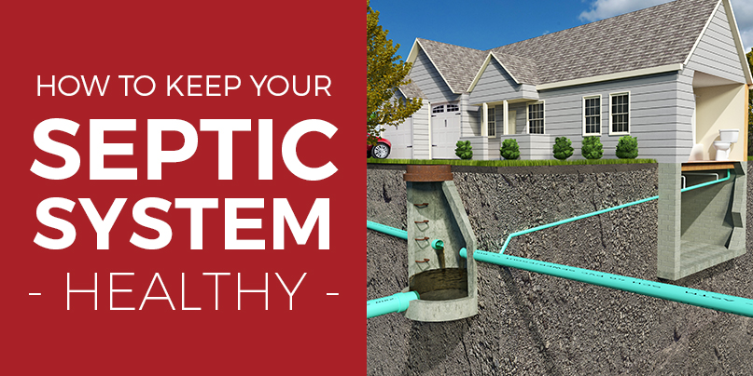
The septic system is one of the most crucial yet overlooked functional elements of a residential property. Even  though many homeowners across the United States have septic systems, not many people actually know where the tank is located. More critically, most people are unaware of the steps that need to be taken to ensure the health and longevity of a septic system. Consequently, septic systems are often taken for granted and are sometimes mistreated by homeowners who fail to manage their water responsibly.
though many homeowners across the United States have septic systems, not many people actually know where the tank is located. More critically, most people are unaware of the steps that need to be taken to ensure the health and longevity of a septic system. Consequently, septic systems are often taken for granted and are sometimes mistreated by homeowners who fail to manage their water responsibly.
Care and periodic maintenance of the septic system are crucial because component repairs can sometimes be costly. If problems get to the point where an entire septic system must be replaced, the costs can range from $3,000 to $10,000, whereas the cost for routine septic pumps generally falls within the $100 to $300 range. However, with proper maintenance, a septic system can last for anywhere from 25 to 30 years on most residential properties. If you move into a home with a relatively new septic system, that system will likely last for your entire residential occupancy if you treat it properly.
How the Septic System Works
A septic system consists of two main parts, the tank, and the drain field. The former receives wastewater from the kitchen, bathroom, and laundry room. When the wastewater enters the tank, the solid elements of the waste sink to the bottom, which forms the sludge layer. Meanwhile, elements of grease and lighter solids float to the top, and this forms the scum layer. The separation of layers takes roughly a day for each inbound supply of wastewater.
Between these layers of scum and sludge, water pushes through and out into the drain field. The scum and sludge are eaten up by bacteria over time, and this prevents the top and bottom layers from growing too large too fast. However, sometimes the bacteria cannot keep up with the inbound volumes of wastewater into the tank. When this happens, impurities can get pushed out into the drain field. In any case, a septic tank must be pumped every three to five years to prevent the scum and sludge layers from rising too high.
Don't Overload the Septic Tank and Drain field
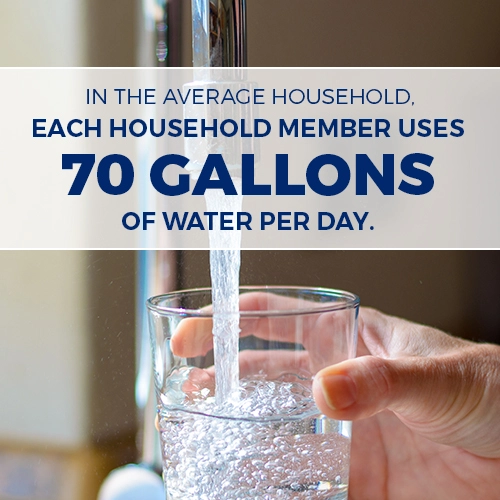 In the average household, each household member uses 70 gallons of water per day. However, all it takes is one tiny leak or a running toilet to waste an additional 200 gallons of water each day. Even such a small leak could more than double the amount of water usage in a house with two people. When you consider how many leaks might occur simultaneously throughout homes in a given vicinity, the wasted water can put a strain on local water supplies and local drain fields.
In the average household, each household member uses 70 gallons of water per day. However, all it takes is one tiny leak or a running toilet to waste an additional 200 gallons of water each day. Even such a small leak could more than double the amount of water usage in a house with two people. When you consider how many leaks might occur simultaneously throughout homes in a given vicinity, the wasted water can put a strain on local water supplies and local drain fields.
Does Shower Water Go Into the Septic Tank?
Yes, all water that exits the house goes through the septic system. That includes shower water, kitchen water, laundry water, and every flush of the toilet. Consequently, leaks and other water-wasting issues can be troublesome for the septic tank. It's important to take steps to eliminate wasteful water usage in your kitchen, bathrooms, and laundry room. The following steps are some of the fundamental ways you can care for your septic system from the comfort of your home.
Use less sink water. One of the most effective ways to protect your septic system from wear and tear is to ease up on the amount of water that enters the tank in the first place. For starters, don't allow too much water to go down the drain for any particular reason. The best way to do this is to practice the following steps:
- Washing dishes. When you wash dishes by hand, don't keep the water running the whole time. Keep the water off at first and lather up the sponge with soap. Scrub the gunk off each dish and utensil, and then turn on the water to rinse everything off.
- Washing hands. Lather your hands up with soap, but don't turn on the water until you're ready to rinse them off.
- Brushing teeth. Don't leave the faucet running as you brush your teeth. Only turn the water on to rinse your mouth and brush.
Take faster showers. While it might feel nice to take long hot showers, it's better on your septic system if you make each shower quick. After all, the main purpose of a shower is to clean yourself. If you wish to soak in warm water for 30 minutes or more, take a bath. Showers are wasteful in comparison, especially when they carry on for more than 45 minutes, during which time you might use enough water for a dozen baths.
Apply nozzles to the faucets. Another way to preserve water is to limit the amount of water flowing through the sink and shower faucets. Attach an aerator to the faucet of any sink that lacks one. Also, attach a flow reducer to your shower nozzle if one is not in place already. These attachments allow you to adjust the water pressure through each faucet and reduce the overall volume as you wish.
Check for faucet leaks. Does your faucet leak at the tap or the base? If so, the tension is either off or the faucet needs to be replaced. Just one leak can result in a whole lot of water waste. To stop this wasteful flow of water, call Mr. Rooter® Plumbing immediately.

Maximize dishwasher loads. A dishwasher can waste lots of water if you use it after every small meal. Preferably, the dishwasher should only be used once it's filled to capacity. If you use it more often due to a limited supply of dishes and utensils, it's time to stock up on more of those household essentials. To ensure that you never run out of dishes before the machine fills up, make sure that your total array of dishes surpasses the capacity of the dishwasher.
Maximize washing machine loads. Washing machines can also waste a lot of water and consequently be hard on your septic tank. To address this problem, try to maximize the loads. If you use the laundry machine every time one of the members of your household needs to clean a shirt or pair of pants, you’re wasting water. You should only run laundry cycles when the laundry basket becomes full.
You can also conserve water by adjusting the water level according to the size of a given load. For instance, if you only have a half–full basket of clothing items to wash, set the machine to the small–load cycle. While the feature exists on most modern washing machines, many homeowners ignore this feature and simply set their machines to maximum loads, which can be wasteful and damaging to a septic system.
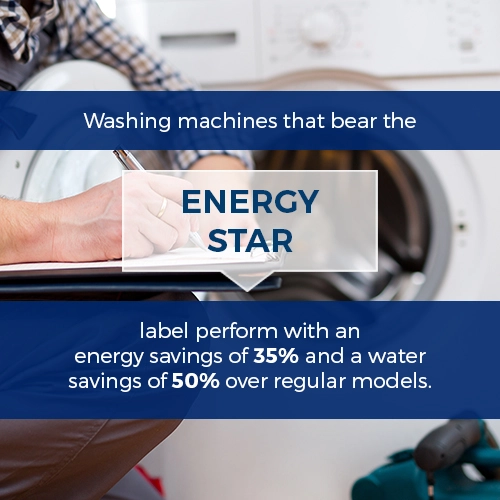 When you invest in a new washing machine, always look for the ENERGY STAR label. Washing machines that bear this label perform with an energy savings of 35 percent and a water savings of 50 percent over regular models. As such, it takes two cycles to use up the same amount of water as a single cycle on an older model.
When you invest in a new washing machine, always look for the ENERGY STAR label. Washing machines that bear this label perform with an energy savings of 35 percent and a water savings of 50 percent over regular models. As such, it takes two cycles to use up the same amount of water as a single cycle on an older model.
While it's best to maximize a load cycle, it isn't wise to run several washing cycles in a single day. In large households, several basket loads will often fill up in the span of a week, and washing cycles are typically handled in succession in the same afternoon. This can be hard on a septic system because it overloads the tank and doesn't allow enough time for the system to treat the water properly. If your household amasses several basketfuls of laundry in the span of a week, spread the laundry cycles throughout the week, such as one load on Sunday, one load on Tuesday, and one load on Thursday.
Use an Efficient Toilet
Roughly 25 to 30 percent of all water use in a typical household is accounted for by the toilet. In older homes, toilets are equipped with reservoirs that range from 3.5 to 5.0 gallons. However, newer homes are often equipped with more efficient toilets that use only 1.6 gallons per flush. This means more than 50 percent water savings over older toilet models.
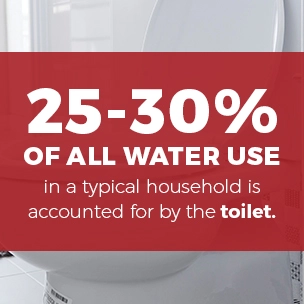 If your toilet is old and built with a large reservoir, consider having it replaced with a modern, high–efficiency model. Reducing the amount of water that flows through the toilet will make things easier on your septic system and lower the likelihood of needing repairs in the long run.
If your toilet is old and built with a large reservoir, consider having it replaced with a modern, high–efficiency model. Reducing the amount of water that flows through the toilet will make things easier on your septic system and lower the likelihood of needing repairs in the long run.
Don't Treat the Toilet as a Garbage Disposal
The toilet is not meant to be used to dispense food items, especially not the kinds of items that could clog your garbage disposal. Never flush down hair, coffee grounds, cat litter, paper towels, grease or oil, pasta, flour, tampons, diapers, condoms, or cigarette butts. A toilet shouldn't even be used to flush away Kleenex, which is better dispensed with in the trash. In only a short amount of time, these items could clog up your septic tank, if they don't clog your toilet first.
Don't Pour Grease Down the Drain
One of the worst things to pour down the drain is grease. Unfortunately, people pour grease down their drains all the time, simply because grease is a liquid that often needs to be disposed of as a cooking byproduct. While it might seem that grease would simply wash right down the pipes, grease can actually form gunk along the inner lining of your drainage pipes and also clog the septic drain field. If too much grease enters the septic system, you could soon be facing the costly expense of a new drain field.
Divert Rain Water From the Septic Drain Field
One of the most damaging things to a drain field is water saturation, which can occur when too much rain collects in that area. When the drain field gets soggy, it's incapable of handling liquid waste. To prevent your drain field from becoming saturated with rainwater, have the landscape and gutters arranged to lead rainwater away from the drain field. Make sure also that the gutters on your roof don't point water toward the drain field, as this can make the soil over such areas soggy.
Keep Trees Away from the Septic System
Perhaps one of the biggest enemies of your underground drainage system is roots, especially large and aggressive ones. When a root encroaches on your pipes and tank, it can lead to backups or other damage in your septic system. To prevent roots from growing around your septic system, keep all trees at least 100 feet away from that part of your property. Trees with extremely aggressive roots, such as willows, make this distance even greater. The last thing you want is to have the pipes or tank punctured by a tree root.
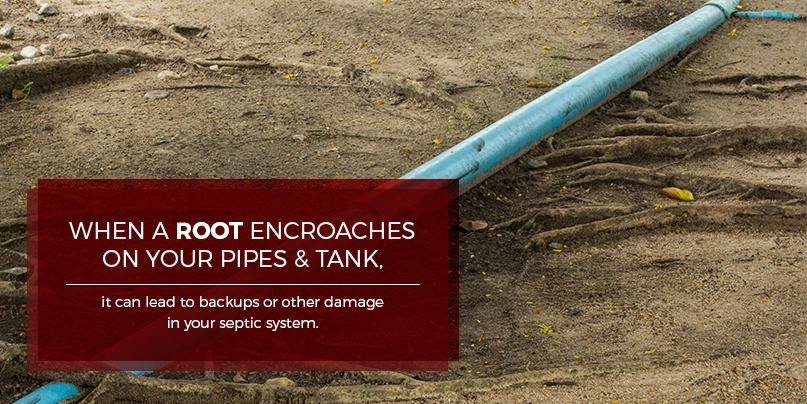
Use Garbage Disposals Wisely
Only use the garbage disposal to dispose of unconsumed or rotted soft perishables such as old tomatoes, bananas, and oranges. Do not use the garbage disposal for anything that would clog a drain or form gunk along the inner–walls of the sewage pipes. Furthermore, refrain from using the garbage disposal frequently or for too much food, so as not to overfill the solid layer in your septic tank. While you might imagine that the garbage disposal blends things into smooth liquid form, they’re actually only chopped into small, often hard bits.
As an alternative to the garbage disposal, consider making a compost pile in your backyard for expired produce. The decomposed fruits and vegetables can feed back into the soil as fertilizer and serve a better purpose than they would in a landfill or your septic tank. If you do prefer to use a garbage disposal, make sure that it's a heavy–duty
model that can chop foods into the tiniest possible bits. This way, the septic system will be more equipped to digest what comes through the disposal. The rules of what should and shouldn't go down will still apply, but it'll be easier on your septic system.
Minimize Heavy-Duty Cleaners
Living inside the septic tank are tiny little microorganisms that nibble away at the solid waste that exits your house. The biggest threats to these microorganisms are drain cleaners, which have chemical disinfectants that kill off the little helpers. Therefore, over–the–counter drain cleaners can actually do more harm than good to your septic system because the chemicals render the system less capable of handling the solid waste that leaves your kitchen and bathroom. As tempting as it might be to use these heavy-duty cleaners, it just isn’t worth it.
Use Septic Safe Products
When it comes to soaps, towels, and other hygiene products, only use brands that are safe for septic systems. Chose hand soaps and dish soaps made from natural products that are friendlier to the environment than chemical–based soaps. These will be easier on the septic system. Also use pre–moistened tissue paper and soft brands of toilet paper, as these will be easier for the septic system to handle. Just as paper towels can clog up a toilet, regular brands of tissue paper can be hard on a septic tank when they enter in large quantities.
Avoid Hazardous Chemicals
Toxic chemicals and oils are unhealthy for groundwater. Because of this, products such as motor oil, paint thinner, gasoline, and varnish should never be poured down the sink or flushed down the toilet. Instead, these products should be disposed of the correct way, as advised on the product labels or according to local law.

Protect Your Septic System From Damage
To keep your septic system healthy and free of damage, it's important to protect the area around the system, especially the ground above. To preserve the soil that surrounds the septic tank, ensure the area is always covered with lawn grass. Don’t use that ground above the septic tank as the location for a playground structure, hot tub, gazebo, deck or parking space. Never drive vehicles over the septic area or cover the overlying soil with asphalt or gravel.
Have Maintenance Performed on Your Septic System
A septic tank needs periodic maintenance to remain working and healthy throughout the average span of residential occupancy. Solid waste, in particular, needs to be pumped from the septic tank at periodic intervals. While systems can vary, most experts advise it's that households of four with 1,000–gallon septic tanks should be serviced every five years or less. Such maintenance work should never be a DIY undertaking, because the germs
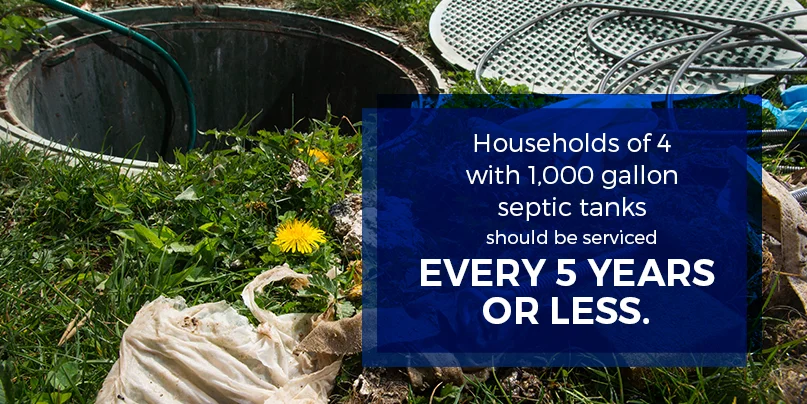
and gases from the septic tank can be dangerous. Always call the service professionals at Mr. Rooter for your septic maintenance needs.
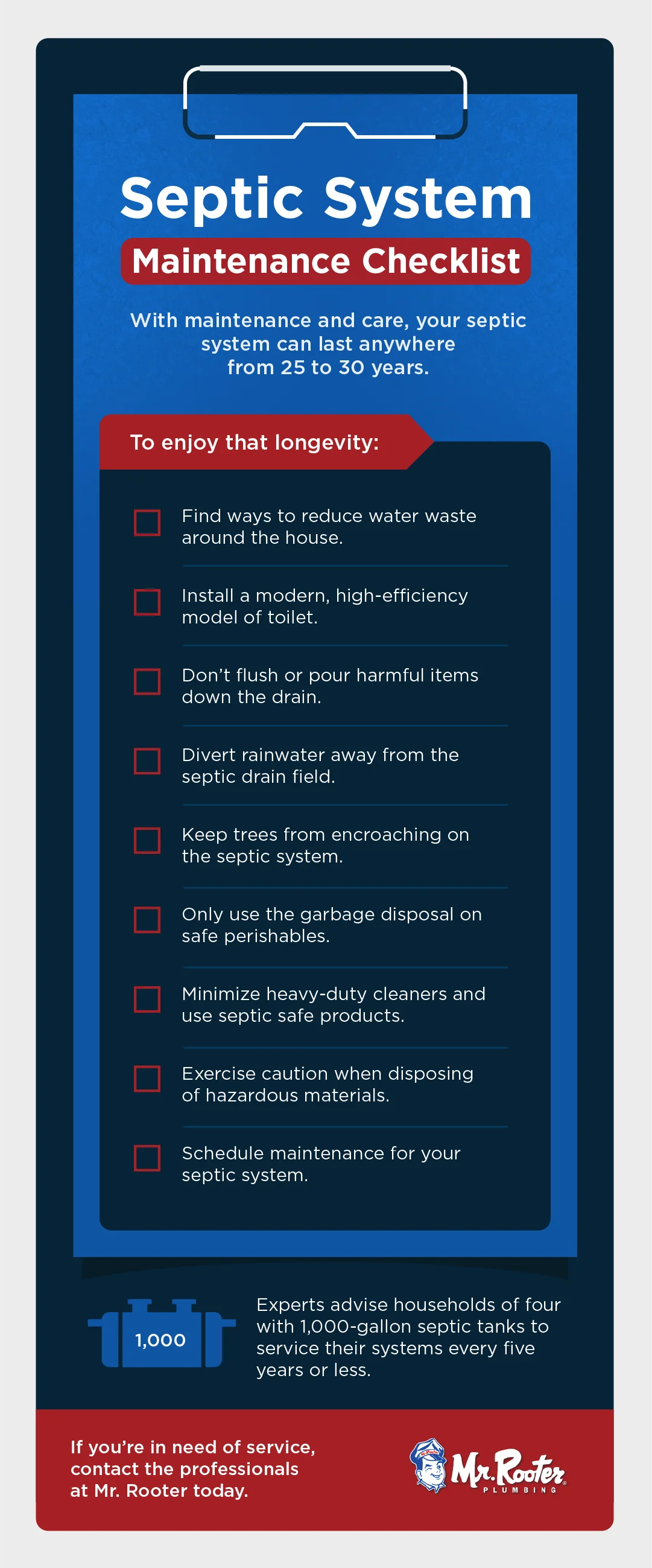
Don't Drain Hot Tubs Into the Septic System
Hot tubs are an added attraction on many of today's residential properties, but you must be careful about hot tub drainage near a septic system. Just one tub full of water can overload a septic tank and force all the gunk and scum right through the outlet drain, which would then contaminate the local water system and possibly cause the tank to fail. Just as importantly, a hot tub should never be installed above the septic system area on a property.
If you have a hot tub installed on your property, have it placed on the side of your house opposite from the septic system. For safe drainage, empty the water onto a turf or landscape that directs the flow away from your house and the septic drain field. Check the laws in your state or county for more information on how to safely drain a hot tub.
Be Careful With Water Softeners / Freshwater Treatment Systems
For many modern homeowners, water softeners may seem like a good way to ensure the health and cleanliness of your water. Water softeners lessen the hardness of tap water with the use of salt, which causes an ion exchange. While the water might be softer on your digestive system, the effects of its production can be hard on your septic system.
Water softening sends excess amounts of salt into the septic tank, which can disrupt the septic system's process of soil dispersal. Even worse, water softeners rapidly release hundreds of excess gallons of water into a septic system. As such, a water softener can overload your tank and push impure hardened particles into the drain field. Therefore, it's best to contact a plumbing professional to discuss different drain–routing options if you choose to use a water-softening system in a house connected to a septic system.
Health Problems Attributed to Poor Septic Maintenance
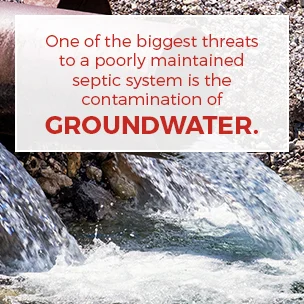 One of the biggest threats to a poorly maintained septic system is the contamination of groundwater, which can occur when water waste isn't properly treated within the tank before it reaches the outlet drain. When the groundwater becomes contaminated, it can have ill effects on nearby flora, fauna, and bodies of water. Local lakes and streams can become polluted, while the impact on drinking water can make it dangerous for humans. The effects can also lead to rapid algae growth and can harm nearby aquatic life.
One of the biggest threats to a poorly maintained septic system is the contamination of groundwater, which can occur when water waste isn't properly treated within the tank before it reaches the outlet drain. When the groundwater becomes contaminated, it can have ill effects on nearby flora, fauna, and bodies of water. Local lakes and streams can become polluted, while the impact on drinking water can make it dangerous for humans. The effects can also lead to rapid algae growth and can harm nearby aquatic life.
In communities affected by water contamination, illnesses such as typhoid fever, hepatitis and dysentery have been known to occur. The nitrates and phosphates in contaminated water can lead to conditions such as blue baby syndrome, which is characterized by a newborn's reduced ability to receive oxygen in the blood. Essentially, when you maintain the health of your septic system, you'll also be doing favors for the health of you and your loved ones.
Frequently Asked Questions about Septic Systems
The Internet is constantly flooded with questions on how to care for a septic system and related concerns, such as how to check a septic tank, how to locate a septic tank, and what to do when water doesn't flow through the septic tank. While it's good to know as much as possible about your septic system, there's a rule of thumb to keep in mind — septic system care from within your home is totally under your control, but maintenance of the system itself is best left in the hands of licensed service professionals.
How to Care for Your Septic System?
There are many things that you can do to care for your septic system from inside your home. For starters, make sure that less water overall is used in your kitchen and bathroom sinks. This can be accomplished with shorter handwashing and dishwashing durations. Instead of leaving the faucet running the whole time that you lather up or scrub up, do the lathering and scrubbing with the water off, and only flip the faucet on to rinse. You're also less liable to space out and over–rinse when you don't leave the water running, but turn it on and off instead.
Things are also easier on the septic system when you take shorter showers, maximize your laundry loads, and spread each laundry cycle out by two or more days. You can also employ a similar strategy with the dishwasher by only running full loads, instead of once or twice–daily small loads.
How Do I Keep My Septic System Healthy?
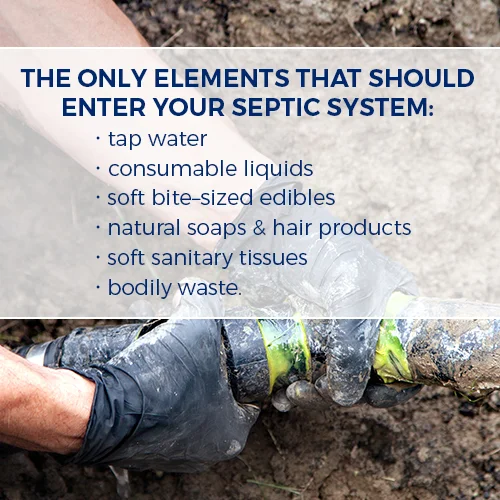 To keep your septic system healthy, you need to make sure that only the right kinds of elements enter the system — namely tap water, consumable liquids, soft bit–sized edibles, natural soaps and hair products, soft sanitary tissues, and bodily waste. To ensure that only natural, soft products and liquids enter your drains, you should only allow those kinds of products anywhere near your sinks.
To keep your septic system healthy, you need to make sure that only the right kinds of elements enter the system — namely tap water, consumable liquids, soft bit–sized edibles, natural soaps and hair products, soft sanitary tissues, and bodily waste. To ensure that only natural, soft products and liquids enter your drains, you should only allow those kinds of products anywhere near your sinks.
To prevent unnatural products from entering your septic system, don't buy chemical–based toxic products unless there are no alternatives available. Don't allow hard edibles to slip down your kitchen sink, regardless of whether or not you have a garbage disposal. Refrain from grinding up broccoli stems, hard carrots, and flowery edibles in the disposal, as these foods can be hard on the septic system. If an unused food item is too hard, dispose of it in a compost pile.
How Do You Check Your Septic Tank?
The reality is that you don't inspect your septic tank. Instead, you have a licensed service professional check the tank and tell you about its condition. That way, you can keep records of the state of your septic system on a year–by–year basis and this can help you determine when your tank will be due for its next pump. Some homes only need two pumps per decade, while others need three.
You shouldn't inspect your septic tank because of the noxious gases and chemicals contained within, which can be unbearable to breathe and dangerous to approach. Licensed service professionals are trained to do this sort of work and have the proper protective gear and tools for opening septic tanks. However, if you still insist on checking your own septic tank, take a safety class on the matter and purchase protective clothes, tools, gloves, and facial gear for the task.
How Often Do You Have to Pump a Septic Tank?
A septic tank should be pumped whenever the scum and gunk layers rise too high within a septic tank. Even though both layers are generally kept down to size by the tiny microorganisms that eat away at such elements, the scum and gunk will grow out of hand after a few years. This process might be sped up if the bacteria are harmed by the regular use of chemical cleaners.

When you have your septic tank inspected each year, look at the level to which the scum and gunk have risen. Once those levels get too close to the outlet drain, it's time to call Mr. Rooter and have the septic tank pumped. If you wait too long, the scum and gunk could flow into the drain field and cause a whole host of health and sanitation problems.
How Do You Maintain a Septic Tank?
To maintain a septic tank, you need to have it inspected each year. During this inspection, take note of the scum and sludge levels. Ask the service professional to give you a record of the inspection, with notes on the condition of the tank and the height of the scum contained within. If the scum is too high, it's time to have the tank pumped. Although the process is different for every tank and every house, a good general rule is that a tank should be pumped every three to five years.
You must also protect the septic system to ensure that it doesn't get overloaded with water or compromised with impure elements. Don't pour toxic chemicals down the drain or flush paints or flammable cleaning formulas down the toilet. If you paint your rooms, clean the rollers off with paper towels and dispense with the paint at a county–designated chemical disposal location.
How Do I Locate the Septic Tank?
To find the location of your tank and drain field, check your basement and look for the drainage pipes to see which direction they point to from out of the house. The front of the septic tank is located at the point where the inlet from the house connects. The lid of the tank will typically be between 12 and 16 inches in from the middle of the tank.
What is the Smell Coming From My Sink/Toilet/Shower?
 The drains in your house are designed with U–curves in the outgoing pipes from your sinks and toilets. The purpose of this curvature is to trap a select amount of the water supply at all times. This water serves as a seal that blocks out the noxious gas and stench from your septic system. If it weren’t for this sealing water supply, the stench in your house would become insufferable.
The drains in your house are designed with U–curves in the outgoing pipes from your sinks and toilets. The purpose of this curvature is to trap a select amount of the water supply at all times. This water serves as a seal that blocks out the noxious gas and stench from your septic system. If it weren’t for this sealing water supply, the stench in your house would become insufferable.
If you smell foul, foreign odors from your sinks and toilet, it could be due to a failure of the drain in question to trap this sealing water properly.
Is the Use of Vinegar in the Washing Machine Problematic for Septic Tanks?
As an edible product, vinegar is not harmful to your septic system. The products that can harm your septic system are toxic, flammable cleaning products. As it is none of these, vinegar can be used in a range of capacities with no ill effects on your drainpipes or septic tank.
Why Won't Water Flow Out of My Septic Tank?
If the septic tank fails to drain properly, it could be one of three possible issues:
- The tank isn't filling with enough water to rise to the level of the outlet pipe.
- A leaky crack exists at the bottom or along the lower sides of the septic tank.
- An obstruction is present along an early stretch of the outlet pipe.
If any of these problems arise, the matter should be handled by a plumbing professional. Call Mr. Rooter if your septic tank fails to drain properly.
How Do I Clean the Toilet Bowl With a Septic System?
It's best to stick with natural products that won't kill the vital, waste–eating microorganisms that live in your septic tank. Check the labels on cleaning products for a septic–safe label, or use a homemade mix of vinegar and bicarbonate powder. While it might be tempting to resort to the products that are advertised to kill 99.9 percent of all germs, these products can harm your septic system. Non–chemical cleaning products are better for the environment, which includes the drain field of your septic tank.
What If My Septic System Hasn’t Been Used for More Than Half a Year?
In most cases, a septic system will not display any performance issues after reasonable periods of disuse. At most, the septic tank will have a supply of long–decomposed waste. If you do have questions about the state of your dormant septic tank, call Mr. Rooter for an inspection.
How is Scum Taken out of a Septic System?
In some cases, the process of scum removal from a septic system involves removing the manhole lid and digging out the scum with a certain type of shovel designed for this work, though this isn't a DIY task. Scum removal should always be handled by a septic systems professional. Call Mr. Rooter if you need scum removed from your septic system.
What to Note from a Service Provider
When you have your septic tank inspected by a service provider, the scum and sludge levels within the tank will be noted for their proximity to the bottom of the outlet. If the scum level comes within six inches or the sludge level comes within 12 inches, it's time to have the septic tank pumped. Each time an inspection occurs, take note of the scum and sludge levels to determine when the next pump will be necessary. Keep records of all of these inspections. You should also take note of where your septic system is so you can report the location to a service provider when he arrives at your house.
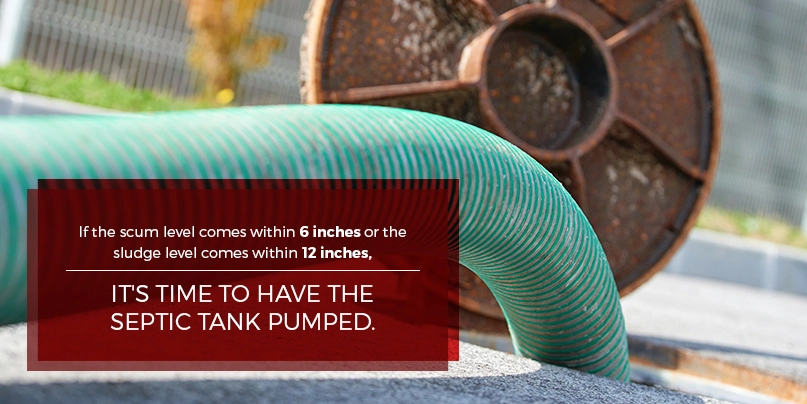
The purpose of tank pumping is to prevent sludge and scum from reaching the outlet and entering the drain field. A service provider might also discover other problems with the tank, in which case you'll want to have repairs done to prevent the issue from spiraling out of hand.
Get Service on Your Septic System from Mr. Rooter Plumbing
When it comes to the health of your septic system, the things that you do in your kitchen and bathroom can ultimately affect the life of the tank and the health of the drain field. While the tank will ultimately need a pump at least every five years, the system can easily last for up to three decades as long as you keep up your end of the bargain and treat your septic system properly.

Numerous symptoms could indicate that it's time to call a septic service professional. If you smell septic odors within your home, it's likely due to a lack of sealant water in your sink or toilet, and this is a job for a professional. If the water fails to drain properly, there could be an obstruction in or around the septic tank, and this is something that can only be handled by someone licensed for such tasks.
These are just some of the septic system problems that have prompted people in the Onondaga County area to call the service professionals of Mr. Rooter Plumbing. Here at Mr. Rooter, we've been helping residents with their septic systems since 1970. If you need to get your water draining properly, call Mr. Rooter for a diagnosis and a solution to the problem. Before the sludge and scum levels in your septic tank run too high, call a Mr. Rooter service professional to have the tank pumped.
At Mr. Rooter, our goal is to offer hassle-free service on your plumbing issues. Members of our team will come out to your home, check out the issue at hand, and give you a diagnosis of what exactly is at fault. Before you have any septic system issues that develop and spiral out of hand, contact the service professionals here at Mr. Rooter to schedule an appointment for routine maintenance.

